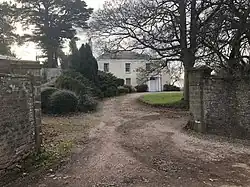| Brynderi House | |
|---|---|
 | |
| Type | House |
| Location | Llantilio Crossenny, Monmouthshire |
| Coordinates | 51°51′02″N 2°52′53″W / 51.8505°N 2.8814°W |
| Built | 19th century |
| Architectural style(s) | Regency |
Listed Building – Grade II* | |
| Official name | Brynderi House |
| Designated | 19 November 1953 |
| Reference no. | 2074 |
 Location of Brynderi House in Monmouthshire | |
Brynderi House, in the hamlet of Brynderi, Llantilio Crossenny, Monmouthshire is a country house with origins in the mid-18th century. The house was extensively rebuilt in the early 19th century in a Regency style. In the later 19th century the house become the dower house for Llantilio Court. A Grade II* listed building, it remains a private residence.
History and architecture
The service block to the house, dating from the mid-18th century, forms its earliest part.[1] The Nicholas family, which owned the house from its construction, added a large villa at right angles to the service wing in the early 19th century. Joseph Bradney, in the Skenfrith volume of his multi-part A History of Monmouthshire from the Coming of the Normans into Wales down to the Present Time, records the house being owned at this time by a Dr. George Nicholas, and subsequently his son, Francis. Owners of a school in Ealing, they used Brynderi "as an occasional residence to which they used to resort in the holidays".[2] Its name was changed to Belmont in the early 19th century, reverting to Brynderi on its purchase by a Colonel Clifford in 1854.[2] The house was subsequently sold to the Jackson (later Mather Jackson) family of Llantilio Court, who used Brynderi as the dower house for the estate.[1] Further extensions to the house were undertaken in 1895. The Gwent County Archive records the occupant in 1916 as "Gertrude Elizabeth Mather Jackson of Brynderi, near Abergavenny, spinster".[3] The house is constructed in a Regency style, which is uncommon in Monmouthshire and the architect of the villa is unknown. The architect of the 1895 extension was A. E. Johnson of Abergavenny.[1] Of stucco, the house is of two-storeys with attics and a Welsh slate roof. The porch is in a Doric style and the wrought-iron veranda is original. The staircase hall, and much of the interior, is largely intact.[4] It remains a private residence and is a Grade II* listed building.[1] Unusually for a building with such listed status, Brynderi is not mentioned in John Newman's Monmouthshire volume of the Pevsner Buildings of Wales.[lower-alpha 1][5]
Notes
- ↑ John Newman's only reference to Brynderi is to the Free Grammar School founded by James Powell.[5]
References
- 1 2 3 4 Cadw. "Brynderi House (Grade II*) (2074)". National Historic Assets of Wales. Retrieved 12 February 2021.
- 1 2 Bradney 1991, p. 112.
- ↑ "James Powell's Charity". Gwent Archives. Retrieved 12 February 2021.
- ↑ "Bryn-Deri House (36533)". Coflein. RCAHMW. Retrieved 12 February 2021.
- 1 2 Newman 2000, p. 352.
Sources
- Bradney, Joseph (1991). A History of Monmouthshire: The Hundred of Skenfrith, Volume 1 Part 1. Academy Books. ISBN 1873361092. OCLC 669714197.
- Newman, John (2000). Gwent/Monmouthshire. The Buildings of Wales. London: Penguin. ISBN 0-14-071053-1.